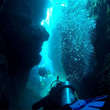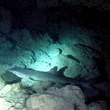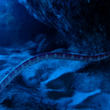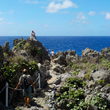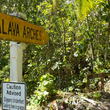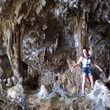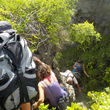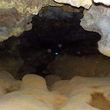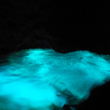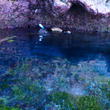This page is an automated translation of /nl/niue.html and is awaiting a manual review.
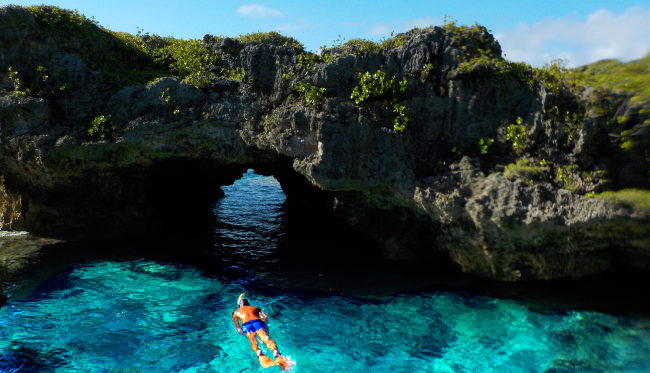
On the way from Suwarrow to Tonga it is only a short detour to Niue. Because we like a detour, we decide to take a look at Niue, even though we have never heard of this small country.
We go over our pilot ("travel guide") which is a bit discouraging about Niue: you can't anchor there so the only option is to use a mooring, the conditions get downright dangerous when the wind turns west, even the dinghies are not safe and you have to hoist the dinghy onto the quay with the help of a mounted crane every visit. We had also heard reports on the shortwave radio of boats that had quite turbulent nights there. Hmmmm.
But the good sides are the fairly large number of whales, the crystal clear water, interesting caves both above and below ground, total lack of crime, beautiful vegetation, etc. We decide to sail towards Niue curiously and in good spirits, after all we can always just continue sailing to Tonga if we don't like it.
Contest
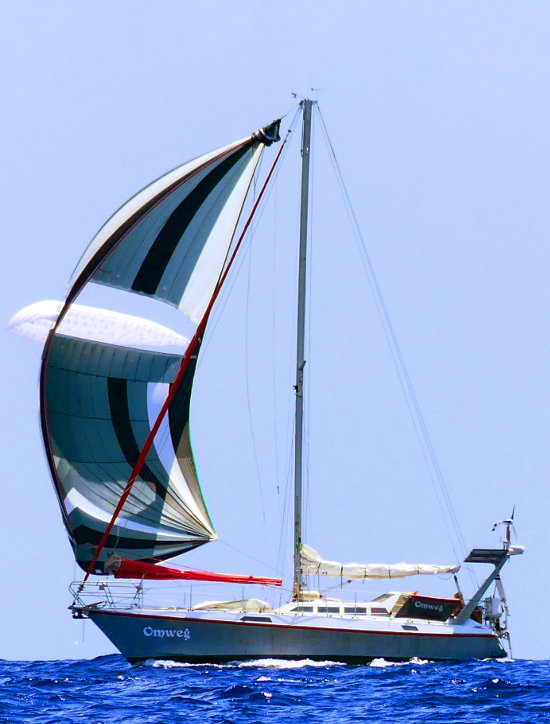
Our friends from the Vaguebond, and Donazita, with whom we traveled on Suwarrow, also decide to set course for Niue, which is about 500 miles away. But when several sailing boats depart at the same time and have the same destination, it is no longer a crossing but a competition! It seems to be a snail competition, because there is little wind. The weather forecast was not really ideal, but nobody wanted to stay longer at Suwarrow so we go for it. The first days there will be little wind, but later it will pick up. The calculated day of arrival looks strange on the weather maps and if we have to believe that information, the wind will suddenly pick up from no wind in a short time to more than 30 knots. Usually there is a reason for such a drastic change in wind strength, but exactly what that reason is remains unclear to us and we have no need to find out what that reason is. However, it will depend on whether we can arrive at our destination before that drastic wind change. Detour is the smallest boat and therefore theoretically the slowest. Vaguebond sails just a little faster than us and disappears from view within a day. At first Donazita has trouble keeping up with us, but when the wind starts to pick up after two days, they also overtake us. However, we remain motivated to continue sailing as quickly as possible because the weather forecast for that last sailing day is still not quite to our liking. Halfway through the crossing the wind starts to increase and becomes a bit gusty and dizzy. Normally we sail slower at night and we don't catch all the wind, but now we go all out. And that means interrupting your sleep now and then at night because the wind has calmed down a bit and you can therefore put on more sail, or that the wind picks up and you have to remove the sudden excess of sail again.
To our surprise, when the sun rises in the morning, we suddenly see Donazita sailing right in front of us! It is a bit like the match of the tortoise and the hare: Donazita thought she had a big lead and could afford a lazy night and we took advantage of that unknowingly. Unfortunately Donazita has now also discovered us and the match starts again. Not for long, because now we have hit the last day of our crossing and there is indeed "strange weather". It starts to rain, getting harder.
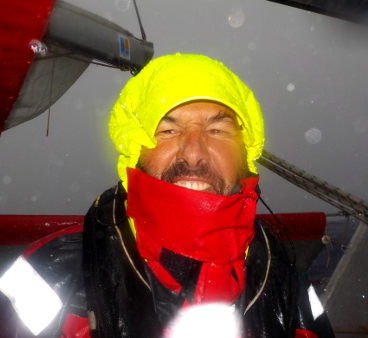
It's getting cold, very cold. For the first time in our sailing career, we are so cold that we put on our brand new warm sailing suits. When I crawl back into the cockpit after the dressing up, I see to my shock that the wind has suddenly turned completely and the jib is standing. Donazita has now lowered the sails and is sailing on the engine. We also use the engine, but try to use the sails as much as possible. The wind, as predicted, does indeed increase to 30+ knots in a short time and is now right on the nose. Donazita is struggling to move forward, but we have a powerful engine and we overtake Donazita, but before dark we will not be able to reach Niue anymore. Via the radio we inform at Vaguebond who arrived just in time at Niue. They tell us that it is no problem to arrive there in the dark, but there is another problem: There is only 1 mooring left. If necessary, we want to moor with two boats, but the authorities on Niue do not agree with that proposal. Because Donazita is hardly moving forward, it becomes clear that Donazita will unfortunately have to spend the night on a rough sea, in the torrential rain and with 30 knots of wind. Despite the GPS coordinates of the mooring passed on by Vaguebond, it turns out to be difficult to find: It is raining, it is heavily cloudy and therefore pitch dark and when we use a lamp we are blinded by the raindrops. After some searching we fortunately find the mooring and we manage to pick up the loop from the water with the boat hook. I quickly draw some lines through the loop and now we are safe for tonight and we can finally go to sleep peacefully. We don't have to fear anything because the wind is offshore and if the mooring were to let go, we just float on the ocean instead of washing up on the shore. We sympathize with poor Donazita but are glad that we continued sailing fanatically when they gave up (and that we have a better engine and propeller) so that we could still come in second! An and Ivan: good job with your Vaguebond !!
On land!

When the sun rises the next morning, it has cleared and we see Niue for the first time. It is a coral island that was pushed up from the ocean long ago by volcanic activity. The top of the island is quite flat, it is a kind of raised plateau about 30-60 meters high. It is an independent small country with a circumference of about 60 kilometers.
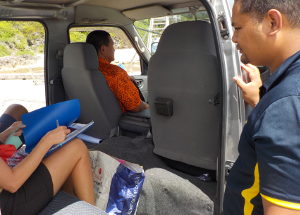
The entire island has beautiful greenery and the coastline is extremely jagged, with protrusions and caves everywhere. This also appears to be the case under water after a short inspection dive. An inspection dive, because when we entrust our Detour to a mooring, we always want to check whether the mooring is indeed anchored and it looks fine. There are some boats leaving so Donazita can now also catch a mooring.
Of course we have to clear the customs before we can go ashore, so we call "Niue radio" on the VHF. We are allowed to clear straight away because customs just happens to be on the quay, but unfortunately we still have to launch the dinghy and this whole procedure will take a bit too much time. Customs will come back to the quay around noon and that suits us better. Clearance is fun: the van that the men come with is the "office", the men are extremely friendly and helpful and tell about Niue. Niue is the smallest country in the world, they have about 1500 inhabitants, more than half of whom work for the government. It turns out that with Omweg we are just behind the government building; we could shoot at the government from the boat with a catapult.
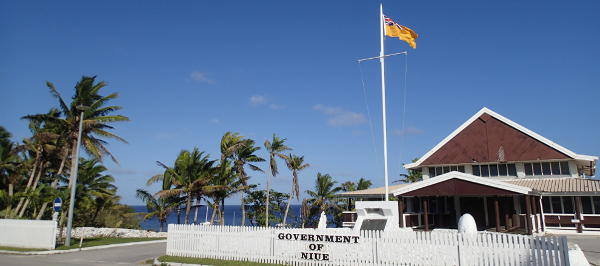

Friendly!
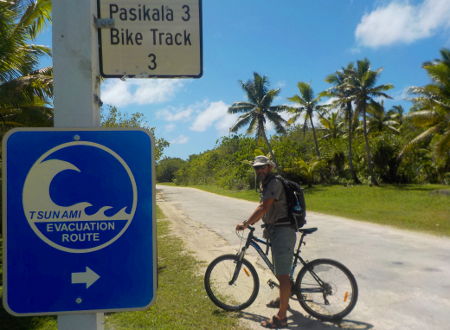

Niue may be the smallest country in the world, but it is also the friendliest country in the world! Everyone is nice to each other and to us. Everyone waves to everyone, and when you walk along the road someone always stops to offer you a lift. Once we wanted to hike a mile and during that time six cars stopped to offer us a lift. Another time we had something to eat in a cafe and we wanted to hitchhike back to the harbor, but the remaining cafe visitors saw that no cars had passed by after fifteen minutes, so someone specially got in his car to follow us to drive and bring to the port ....!
They don't know crime here: The windows are open in all parked cars and the keys are put in the ignition lock. We rent two bicycles that have no lock and even after a night on the quay, the bicycles are still there the next day. We rent a car but do not need to show a passport, no deposit; the confidence is life-sized here. The cruisers that visit the country are not visitors but are lovingly called "yachties" and are included in society. Communication here is not only done by telephone (each telephone number here consists of only four digits!) But also via VHF: You can call up tourist information, diving schools, customs, the yacht club, and so on from the boat. We do not bring cell phones on the island, but handheld radios.
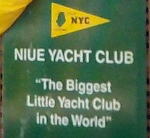
The yacht club is the coolest we have ever seen: it is a real club where you can always walk in, where there is internet, sockets to charge your laptop and stuff, where you can grab a beer from the fridge and have a chat and you can even use the club's car to get fuel for the boat, for example.

Niue is a popular holiday resort for adventurous New Zealanders. There are no hotels here, only small-scale guesthouses. But because of these tourists, it might be possible to set up restaurants and there are plenty of them on Niue (although there may be only 10-15, that feels like a lot because it is such a small country). We go to the only Indian restaurant on the island where we often get a Roti for 3.50 Euro for lunch, we go to the best (and only) pizzeria in the country, eat the most delicious sushi and we go to a place where they serve locally. serving food and performing live. When dining out, as in the rest of the Pacific, it is normal to bring your own drinks. Indeed, you go to a restaurant and you bring your own pack of wine, the restaurant owner will provide suitable glasses. For us it was a strange habit, but it actually makes a lot of sense: you go to a restaurant because of the special food they serve, but usually not for the brand of wine they have. You can also easily get wine there yourself, you don't have to go to the restaurant for that. The common obligation in "the west" to have to buy your drink in the restaurant even if it is only tap water was not invented for the benefit of the customer but is a kind of tying that is advantageous for the hospitality industry, just like the crazy obligation to an amusement park buying everything you want to eat on the spot for way too much money. In a little while you will also have to buy your shoes from the restaurant or amusement park to enter. It's great that there are also parts of the world where not commerce, but the customer is central! Eating out becomes cheaper this way, so we eat out more often and so the restaurants ultimately earn just as much.
Whales and Snakes!

It's not just tourists who visit Niue: the whales also like to come there. The whales are strictly protected; it is forbidden to approach them. Fortunately, you don't have to, because the whales just swim between the moored boats. The whales like to show themselves, some whale mothers have just given birth to a calf and during lactation, which takes about 15 minutes at a time, the mother assumes a typical posture with the tail above the water, which gives spectators ample time to enjoy the enjoy the spectacle. Such a calf drinks 500 liters of milk a day and weighs more than 1000 kilos at birth. Whale season runs from July to October, with August being the really good months.
During Ilona's first snorkeling session, she is attacked by a water snake chasing her. With great difficulty she manages to escape, but when we ask the diving school about it, they have to laugh a bit. The water snakes are unique to Niue, a kind of national symbol. They are super poisonous indeed, but they never bite people, even if you handle them. The snakes perceive the water disturbance of the snorkeler and come only curious to see what is going on. Later on we will see a lot of these snakes and they become "scary" after a while automatically funny and cute! It is a pity that we are not here in the mating season because that is spectacular to experience; hundreds at a time the snakes are then in a certain cave. If you happen to be in the cave, then all those snakes wind around you!

Misa
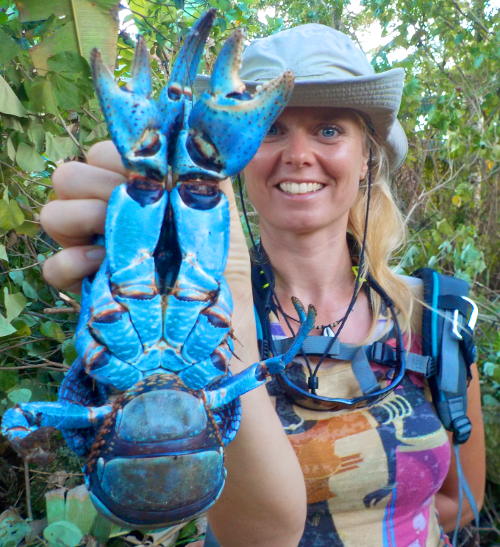
At the information center we find a leaflet from an old man named Misa. He shows how people used to survive on Niue. We make an appointment and we get an impressive tour of his country. He shows how they used to make fire, how they used an underground oven, and for lunch we get a Papaya that is filled with coconut chips, straight from nature and it is a delicious meal. Misa pulls a piece of bark off a certain tree and lets us smell it. The smell is very familiar to us, but we cannot imagine what it is. Until Misa says they used the juice to disinfect wounds. Now we recognize the scent: it's Dettol! We honestly didn't even know this is a product that comes from the bark of some tree.
Coconut palms were very important to the ancient population; Misa calls the tree "the tree of life". The coconut is for drinking and eating and you can make scoops and bowls from the empty nut. The palm leaves there can be made into a BBQ grid because it is very heat resistant, you can weave the roof and walls of your hut because the leaves remain good for years in all weathers, you can use it to weave baskets and from the stem. you can make a heat-resistant clothespin to take things out of the oven.
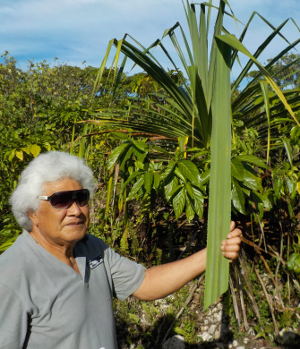
However, we noticed that there are coconut trees everywhere, but that the coconuts simply remain unused under the trees, so we ask Misa how that is. He explains that coconut is said to contain a lot of fats and they are not good for you; it would make you fat and develop diabetes. So the traditional tasty food that we just had for lunch is no longer eaten by the population but fed to the pigs. People now buy their food in the supermarket because that would be much healthier.

In the supermarkets we see that corn, flour, dairy products and potato chips are popular and there are many Western products with even Dutch labels, but the coconuts, papayas and bananas are left rotting outside or are fed to the pigs. Misa does not understand: if coconuts were so unhealthy, why do we now see many more people with overweight and diabetes than before? He understands even less when I say that we grow a lot of beet and corn in the Netherlands, but that this is fed to our livestock and in the meantime we buy coconuts, bananas and other tropical food in the supermarket because it would be so healthy. Especially around coconut products there is a lot of hype because it is not only healthy to eat but also to smear the oil on your skin or in your hair.
It seems that common sense has lost out to commerce, a commerce that simply doesn't like people eating straight from the land, but benefits from people going to the supermarket. So our food is sold here in the Pacific, the food that grows in the Pacific is sold in the Netherlands. The people are led to believe that what you get from afar is better for you ...
Caves

Niue
Niue is known for its caves and jagged landscape. It is a mix of volcanic rock and coral. You can also great hiking, climbing and scrambling and we do that a lot. The pictures taken do not do justice to what it really is like to be there, in low caves where the sea spurts in, in high caves that form a window that looks out over the ocean and where you can see a whale passing by, snorkeling in caves where the fresh inland water meets the salt water of the ocean for very special effects, all surrounded by a tropical forest.
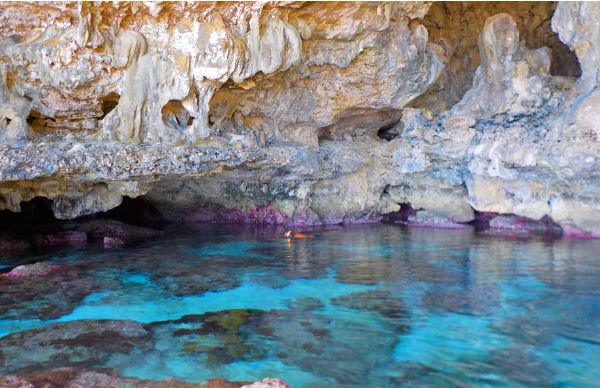
You will find the same landscape under water. While snorkeling and diving around the boat we can already see that the landscape under water looks just like the landscape above it: deep canyons, shades of caves, natural tunnels, and so on. You can dive great, which we do a number of times together with the crew of the Vaguebond, but in such an environment it is not wise to pioneer underwater in caves on your own. We have therefore "ordered" an exciting dive from a local dive instructor, but the dive is postponed every time because the sea would be too restless to launch the boat with which we were going to dive. Because everything that has to enter the water here is let in with a tap and immediately afterwards removed again. You cannot moor your boat somewhere quietly here. We just wait and see while enjoying the other things to do here on Niue.
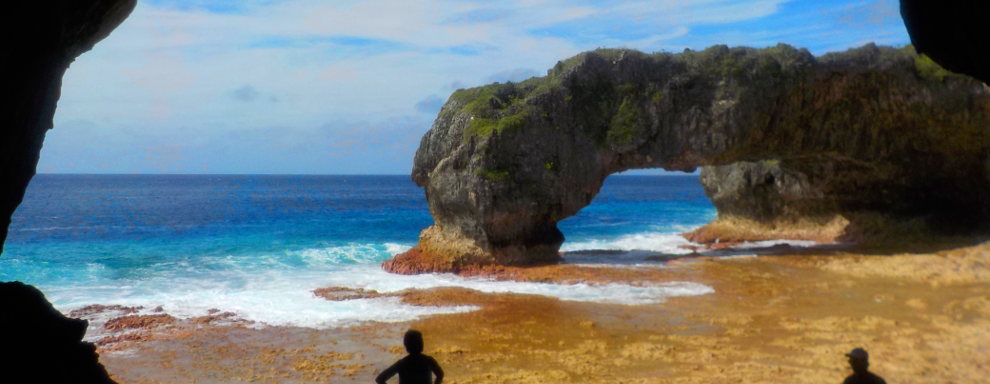
Hip Hip Hooray!!!

The day before Ilona's birthday it turns out that the dive can take place. Enthusiastically we collect our diving equipment and a little later we are picked up from our boat. The Vaguebond crew will also come along. When we start the dive we realize that according to Dutch times Ilona's birthday has already started, so the dive is a nice birthday present! It even turns out to be the most beautiful and fun dive we have ever done! We start at "The chimney", a hole in the seabed through which you can zigzag down to lower yourself. At a depth of about 30 meters you arrive at an exit on a lower plateau and a cave. We enter the cave and armed with diving lights we see all kinds of special plants and animals. We leave the cave and swim through many narrow underwater canyons. We resemble birds floating over and through the special landscape. When the tanks are almost empty we have a break and exchange the bottles for full tanks for the next dive. Now we enter a tunnel, meet a shark that is quietly sleeping and sleeping there, and swim on to a cave that is only half filled with water but has no other access than through the underwater tunnel. Due to the waves on the outside at the surface, the water level in the cave varies in a rhythmic way and in the same rhythmic way the air in the cave is compressed and released again, making it misty and clearing in the same rhythm. It gives a spooky effect.
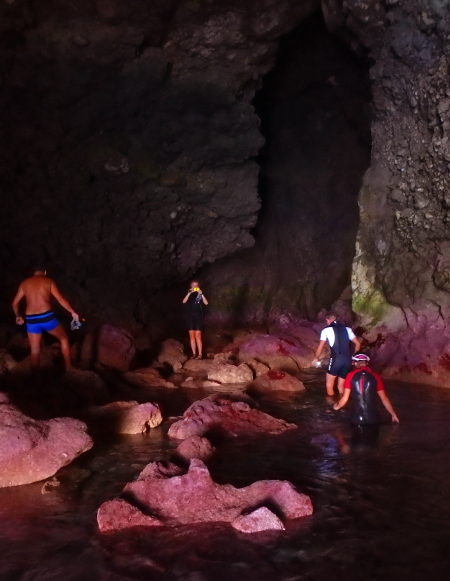
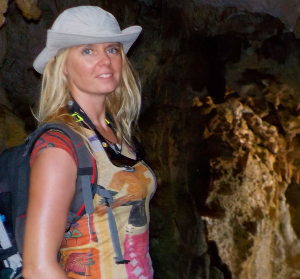
The day after it is really Ilona's birthday in Niue. I have rented an eight-person van and with the crew of Dragonsbane and Vaguebond we leave for an unknown cave that was discovered by Tanja of the Dragonsbane. The Echo Echo crew has rented a motorbike and will follow us. But it is mainly the male half of Echo Echo who is adventurous and after a shower we see the motorcycle disappear. We call them with the handheld VHF, but they think we should continue and the voice tells us that they have something to discuss among themselves.
The cave complex is very beautiful! You can snorkel outside in crystal clear water, you can swim into the cave and after research Ilona discovers that you can walk/crawl deep inside the cave via a long corridor to another small lake. It is completely dark except for a bluish light. Apparently there is an exit to the outside underwater and after brave research it appears that you can indeed get out by swimming underwater and then end up at the reef. Ilona's day cannot go wrong now!
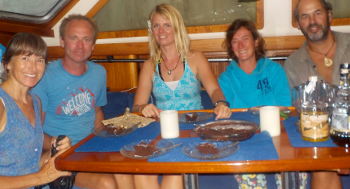
After the walk we drive back and on the quay we meet again the crew of Echo Echo who would like to come along with our bus. We have lunch at the "Wash Away Cafe", one of the few places that is open here on Sundays. The food is good and here too the landscape is beautiful and the water attractive. So a little later we are all snorkeling in the water. It is getting dark when we arrive at the boat. But the day is not over yet: Tanja van de Dragonsbane has baked a cake and invites us to have a small party on board with Vaguebond! We don't make it too late because we want to leave for Tonga the next day in the evening and we still have a lot to do to make the departure possible. Eventually, the next day it turns out that there is not enough wind and we do not leave for Tonga and we enjoy another five days of Niue before a suitable weather gap arrives to reach Tonga pleasantly sailing!
